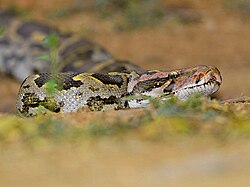For
Burmese pythons — one of South Florida's most notorious invasive
species — few meals are too big, but new research by scientists in
Collier County suggests the snake might be snacking above its weight
class.
While tracking pythons in
Collier Seminole State Park, a group of wildlife biologists from the
Conservancy of Southwest Florida and land managers from the state park
stumbled on an unsettling discovery: an 11-foot Burmese python that had
devoured a white-tailed deer fawn weighing more than the snake.
The
2015 finding, which has since been peer-reviewed and is set to be
published in the Herpetological Review this month, is believed to be the
largest python-to-prey ratio documented to date, with the snake
weighing 31.5 pounds and the deer 35 pounds, said Ian Bartoszek,
wildlife biologist and science coordinator for the conservancy.
"It almost did not compute," he said during an announcement of the findings in the conservancy's snake laboratory Thursday.
"We
were sitting there just trying to process that an animal this size
could get its head around what turned out to be a deer. It's surreal to
see that in the field."
When
the researchers moved the snake out of the wild into an open area that
day, the stressed python began to regurgitate the deer, Bartoszek said.
But
had the snake's meal been uninterrupted, the python would have
eventually fully digested the fawn, which was less than 6 months old, he
said. The python was later humanely euthanized.
Burmese
pythons, which came to South Florida via the pet trade beginning in the
late 1970s and were eventually accidentally or intentionally released
into the wild, have had the delicate local ecosystem in a chokehold for
years.
But the conservancy's recent discovery could
spell more bad news for Florida's already endangered panther
population, Bartoszek said.
"White-tailed deer are the primary prey for our state and federally protected Florida panther," he said. "That's panther food."
With
Burmese pythons capable of reaching near 20 feet in length, finding a
relatively small specimen successfully devouring a fawn heavier than the
snake was "jaw-dropping," Bartoszek said.
"It showed my team and myself what we were actually dealing with out there, what this python is capable of," he said.
To
be sure, Bartoszek said, the pythons, which are apex predators, have
been known to swallow large animals, including alligators. What stunned
the scientists was the predator-to-prey size ratio, he said.
"We
know that they'll take adult deer now and then," Bartoszek said. "If
they're tapping into young deer, then that just makes me a little bit
worried that there will be additional impacts that we haven't even
considered yet."
This
week a hunter in Collier dispatched a 5½-foot-long snake, the 900th
python removed since the program began a year ago, the Water Management
District reported Thursday.
Bartoszek, who
emphasized the importance of Florida's 15 native snake species, said
fully eradicating Burmese pythons is unlikely. The hope, he said, is to
bring the python population under localized control.
In
the future, removal techniques could involve developing pheromones that
could help attract the snakes in the wild, Bartoszek said.
"I
think that's a promising field, and others are working on it in labs
right now. We're assisting them," he said. "We need to use this animal's
biology against them."
A serpente pesava aproximadamente 14 kilos e o cervo 15, como explicou Ian Bartoszek, coordenador da equipa de investigadores. o cientista qualificou o achado como « surrealista ». " Esta descoberta mostrou-nos aquilo que é capaz de fazer este animal " declarou o chefe da equipa. *
* Tradução de " pintorlopes " sendo um breve resumo do articulado. As minhas desculpas pelas falhas e, ou, omissões.
Anexo sob estas linhas duas fotos que obtive na blogosfera para melhor entender-mos do que estamos a falar.
Ciervo de 15 kilos no interior de uma serpente
A Pitón Birmanica é uma grande ameaça para os animais da Florida e é uma espécie invasora .Estudos recentes demonstram que podem chegar a ingerir um animal de um peso maior que o seu.
Enquanto procuravam pitóns no Parque Estatal Collier Seminole, um grupo de biólogos que trabalham em temas relacionados com a conservação a sul da Florida e gestão dos terrenos fizeram um surpreendente achado: viram que uma pitón birmanica de quase 3,5 metros tinha devorado uma cria de cervo que pesava mais que o réptil.
Esta descoberta leva a supor aquilo que se converteu no maior ratio entre o peso do predador e a sua presa, até à data.A serpente pesava aproximadamente 14 kilos e o cervo 15, como explicou Ian Bartoszek, coordenador da equipa de investigadores. o cientista qualificou o achado como « surrealista ». " Esta descoberta mostrou-nos aquilo que é capaz de fazer este animal " declarou o chefe da equipa. *
* Tradução de " pintorlopes " sendo um breve resumo do articulado. As minhas desculpas pelas falhas e, ou, omissões.
Anexo sob estas linhas duas fotos que obtive na blogosfera para melhor entender-mos do que estamos a falar.
 |
| Cervo |
 |
| Cervo e cria |
A píton-indiana (Python molurus) é uma espécie de cobras da família Pythonidae. Pode ser encontrada em Bangladesh, China,
| |||||||||||||||||||||||||||||||||||
|---|---|---|---|---|---|---|---|---|---|---|---|---|---|---|---|---|---|---|---|---|---|---|---|---|---|---|---|---|---|---|---|---|---|---|---|



